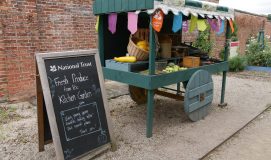The gardens cared for by the National Trust in the area are being harvested by staff and volunteers – and visitors can pick up tasty treats to take home to create seasonal recipes.
Money raised by these donations goes directly into funding the conservation work of the properties.
At the Elizabethan Hardwick Hall, the gardens are bursting with seasonal produce. Volunteers have cared for and gathered fruit, such as damsons and apples, from the orchards and fresh vegetables from the nursery, including tomatoes, courgettes, cucumbers, French beans and beetroot.
Some of these autumnal delights are turned into tasty treats in the café, and some are available for visitors to pick up take home with them. Hardwick’s head chef has shared some of their top seasonal recipes, so you can pick up some apples from the shop and create their tasty Apple and Ginger scones at home.
The Victorian Kitchen Garden at The Workhouse in Southwell used to feed the paupers that lived there, as well as raising additional income. Seasonal produce and herbs would be grown and sold to make a profit, whilst simple goods, like potatoes, would form a staple part of the paupers’ diet. Now you can pick up seasonal delights from the vegetable stall to take home, grown by its team of volunteers.
Clumber Park’s Walled Kitchen Garden was built in 1772 to supply the Dukes of Newcastle with fresh fruit and vegetables, which visitors can buy and take home to create tasty seasonal treats. Today, it’s maintained as a historical feature, and is home to the National Collection of rhubarb, with more than 130 varieties. It’s also home to the regional collection of apples, with more than 70 varieties ripening this season. The garden also houses the longest glasshouse in the care of the National Trust at 451 feet long.
Clumber Park senior gardener Dale Iles said: “Pre-pandemic, the Walled Kitchen Garden provided our kitchens with a lot of seasonal produce for their recipes – including our much-loved rhubarb cake – and this is starting to return, as our café brings back seasonal dishes.
“One of the questions we get asked a lot in the Walled Kitchen Garden is: “why do you leave so much of the rhubarb to rot?” The answer is, you can’t entirely strip a rhubarb plant back or it will die; we need to leave roughly a third of the crown of the rhubarb plant in place to allow it to recharge for next year.



 Posted on 13th Sep
Posted on 13th Sep


